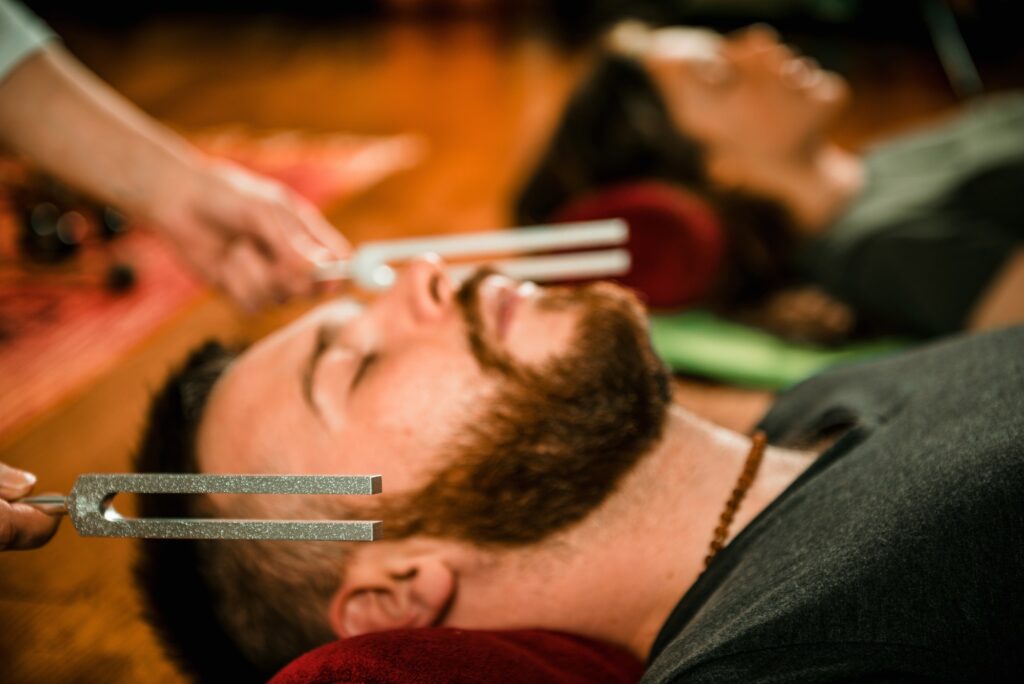
Feeling stressed, anxious, or out of balance? It might be time to tune in to a holistic approach to wellness: sound healing. This ancient practice has gained popularity recently as people are discovering its transformative effects on physical and mental health. Sound healing aims to bring the body and mind back into harmonious alignment by harnessing the power of sound vibrations.
Whether it’s the soothing notes of crystal bowls, the resonating hum of tuning forks, or the rhythmic beats of drums, sound healing can profoundly impact our well-being. Research suggests sound therapy can boost mood, reduce stress, improve sleep patterns, and enhance cognitive function.
But how does it work? The sounds and frequencies emitted during sound healing sessions stimulate the brain, promoting deep relaxation and activating the body’s natural healing processes. As a result, energy blockages can be released, promoting a sense of renewal and restoring balance to the body’s energy centers.
Suppose you’re looking for a natural and holistic way to enhance your physical and mental well-being. In that case, sound healing may be just what you need. Allow the power of sound to wash over you and experience the transformative effects it can have on your life.
The science behind sound healing
Sound healing is an ancient practice that uses sound vibrations to promote healing and well-being. It is based on the belief that everything in the universe comprises energy, including our bodies. When our energy becomes blocked or imbalanced, it can lead to physical and mental health issues. Sound healing aims to restore this balance using various sound techniques and instruments.
Sound healing can be traced back to ancient civilizations such as the Egyptians, Greeks, and Native Americans, who used sound and music as healing. In modern times, sound healing has evolved to incorporate various instruments and techniques, including crystal bowls, tuning forks, gongs, drums, and vocal toning.
Benefits of sound healing for physical health
While sound healing has been practiced for thousands of years, it is only in recent years that scientists have begun to study its effects on the body and mind. Research has shown that sound vibrations can profoundly impact our physiology and brain activity.
When exposed to certain sounds and frequencies, our brainwaves can synchronize with them, leading to deep relaxation. The alpha or theta brainwave state is associated with reduced stress, increased creativity, and enhanced cognitive function.
Furthermore, sound vibrations have been found to stimulate the release of endorphins, which are natural painkillers and mood enhancers. This can explain why many people experience feelings of euphoria and relaxation during sound healing sessions.
Benefits of sound healing for mental health
Sound healing has numerous benefits for physical health. One of the primary benefits is stress reduction. Stress is a significant contributor to many health problems, including heart disease, high blood pressure, and immune system dysfunction. Sound healing can help reduce stress by promoting relaxation and reducing the production of stress hormones such as cortisol.
Additionally, sound healing has been found to improve sleep patterns. Many people struggle with insomnia and other sleep disorders, which can hurt overall health and well-being. Sound healing can help relax the mind and body, making it easier to fall asleep and stay asleep throughout the night.
Furthermore, sound healing can boost the immune system, improve circulation, and alleviate pain. The vibrations created by sound healing instruments can penetrate deep into the body, helping to release tension and promote healing. This can be particularly beneficial for individuals suffering from chronic pain conditions such as arthritis or fibromyalgia.
Power of Sound: Using Music and Sound Therapy for Wellness
Different types of sound healing techniques
In addition to its physical benefits, sound healing can also have a profound impact on mental health. One of the primary benefits is stress reduction. Chronic stress can take a toll on mental health, leading to anxiety, depression, and other mood disorders. Sound healing can help calm the mind and promote inner peace and tranquility.
Furthermore, sound healing can enhance cognitive function. Research has shown that specific frequencies and sounds can improve focus, memory, and concentration. This can be particularly beneficial for individuals who struggle with ADHD or other attention disorders.
Moreover, sound healing can promote emotional healing and release emotional blockages. The vibrations created by sound healing instruments can help release stored emotions, allowing individuals to process and heal from past traumas or emotional wounds.
How to incorporate sound healing into your daily routine
Sound healing encompasses a wide range of techniques and instruments. Here are some of the most popular ones:

1. Crystal Bowl Healing: Crystal bowls are made from quartz crystal and produce pure, soothing tones that resonate with the body’s energy centers. They are often used to balance and align the chakras.

2. Tuning Fork Therapy: Tuning forks produce specific frequencies that can be applied to different body parts to promote healing and balance.

3. Drumming Therapy: Drumming has been used for centuries as a form of healing and meditation. The rhythmic beats of drums can induce a trance-like state and promote relaxation.

4. Gong Bath: A gong bath involves lying down and being bathed in gongs’ deep, resonating sounds. It can promote deep relaxation and release energetic blockages.
Sound healing instruments and tools
Incorporating sound healing into your daily routine can be a simple and effective way to enhance your well-being. Here are some tips to get started:
1. Start by setting aside a few minutes daily to listen to soothing sounds or music. You can use recordings of crystal bowls, nature sounds, or any music that resonates with you.
2. Experiment with different sound healing instruments. You can purchase crystal bowls, tuning forks, or drums and use them during your sound healing sessions.
3. Attend sound healing workshops or classes. Many practitioners offer group sessions where you can experience the transformative power of sound healing in a supportive environment.
4. Combine sound healing with other holistic practices such as meditation, yoga, or breathwork. The synergistic effects of these practices can enhance the overall benefits.
Sound healing and meditation.
Suppose you’re interested in experiencing the transformative power of sound healing. In that case, seeking sound healing practitioners or workshops can be beneficial. These practitioners have extensive training and experience using sound vibrations for healing and well-being.
Attending workshops or sessions led by experienced practitioners can provide a safe and supportive environment to explore the healing potential of sound. They can guide you through various sound healing techniques and help you find the most resonating with you.
Concluding Insights: Embracing the Essence of Sound Healing in Meditation
Sound healing and meditation are closely intertwined practices that can complement each other. Both practices promote relaxation, reduce stress, and enhance overall well-being.
During a sound healing session, the soothing sounds and vibrations can help quiet the mind and deepen the meditative state. Combining sound and meditation can facilitate a deep sense of inner peace and tranquility.
Many sound healing practitioners incorporate meditation into their sessions, guiding participants through breathing exercises and visualization techniques to enhance the healing effects of sound.
